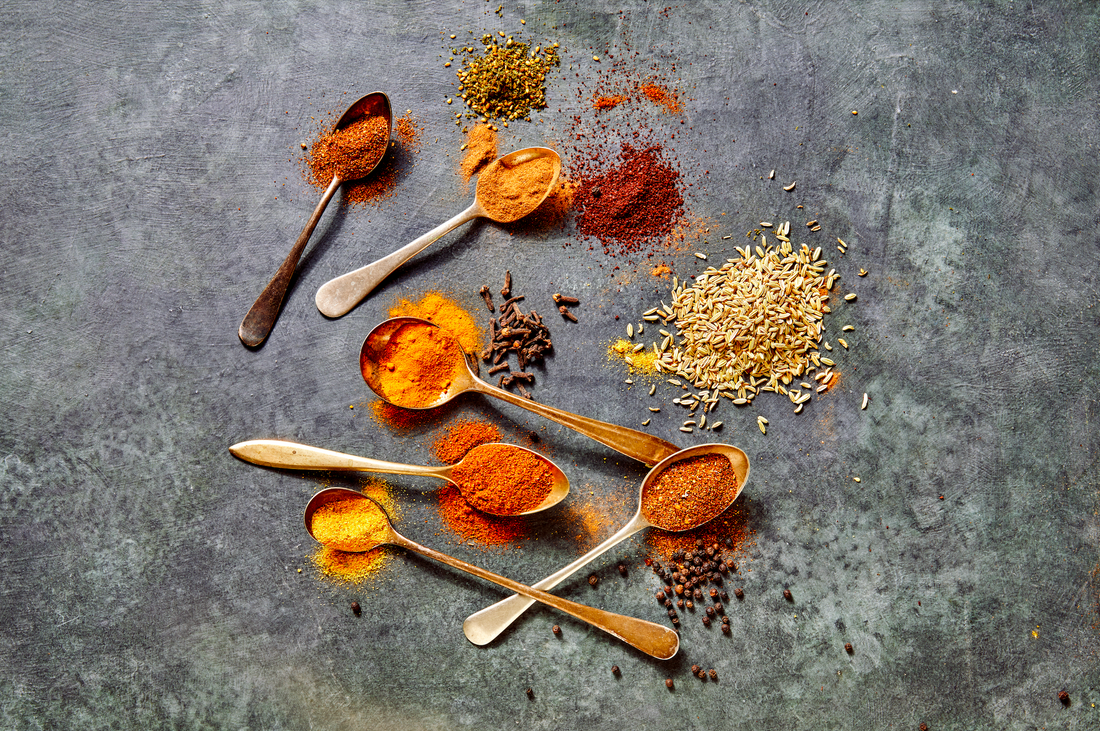
Why Spices and Herbs Are the Missing Link in Gut Health
When it comes to gut health, probiotics often get all the love. But take it from me, they’re only part of the picture. Optimizing gut health starts with a healthy diet, and along with probiotics, spices and herbs can play a powerful supporting role.
Spices and herbs can help good gut bacteria thrive.
UCLA’s Center for Human Nutrition found that extracts of black pepper, cayenne, cinnamon, ginger, oregano, and rosemary promoted the growth of helpful bacteria from the families Bifidobacterium and Lactobacillus—the same types found in most commercial probiotics. In addition, the spices inhibited growth of nasty microbes from the Fusobacterium, Clostridium, and Ruminococcus groups—the ones found in unhealthy digestive tracts.
Gut-friendly spices and digestive herbs may help with digestive motility, improve nutrient absorption, and help with digestive symptoms. Here are 6 of my favorite spices and herbs that can support gut health:
-
Black Pepper contains piperine, which studies have shown that piperine may expand the absorptive surface of the gut, enhance the action of enzymes that transport nutrients into intestinal cells, and increase the blood flow to the GI tract to carry nutrients throughout the body.
Bonus: Pepper makes turmeric even more powerful. Studies show that pepper enhances the effectiveness of curcumin (the anti-cancer nutrient found in turmeric) by up to 2,000%!
-
Peppermint may help with nausea, indigestion, and Irritable Bowel Syndrome (IBS) symptoms.
-
Cardamom has diuretic effects that may help you debloat. And cardamom may provide constipation relief by stimulating your gut and may help relieve abdominal spasms (as in IBS).
-
Ginger may aid in digestion and benefit overall gastrointestinal motility. Pro tip: If you’re feeling bloated, try my natural remedy for bloating recipe that features ginger below.
-
Oregano may support gut health by reducing inflammation and improving the integrity of the intestinal barrier. And oregano may soothe digestive cramps by decreasing smooth muscle contractions in the intestines.
-
Black cumin seeds, also known as the “miracle herb” (unrelated to the cumin in your spice rack), add antioxidant properties and stimulate digestion for GI support.
Supercharge Your Gut Health with Spice Synergy
On top of supporting digestion, spices and herbs can supercharge your meals with antioxidant and anti-inflammatory properties.
An easy way to tap into that nutritional power is through my Spice Blends. They’re expertly crafted to maximize spice synergy, where the ingredients work together to amplify their antioxidant and anti-inflammatory power. Plus, my Spice Blends are made with premium organic spices, so you’re getting pure power with no junk.
Try my Curry Magic, Morning Boost and Pure Italian. They’re three examples from my spice collection that feature amazing spices for gut health. All it takes is a couple of pinches to really sprinkle on the goodness!

Anti-Cancer Debloat Tonic Recipe
PREP TIME 10 MINUTES - COOK TIME 10 MINUTES - SERVES 8
Vegan & Gluten Free
Ingredients
-
8 cups water
-
1 teaspoon fennel seeds
-
1 teaspoon black cumin seeds
-
2 inches turmeric root, sliced into rounds
-
1 inch ginger root, sliced into rounds
-
1 handful parsley leaves
-
1 teaspoon Morning Boost Power Spice Blend.
Directions
1. In a medium saucepan over medium heat, stir together all ingredients.
2. Bring up to a simmer, reduce heat to low, and let simmer 8–10 minutes, until the spices are fragrant.
3. Strain, if desired, before serving warm or chilled. Store covered and refrigerated for up to 4 days.
Sip away the bloat and body inflammation! This morning tonic is the perfect remedy. I use this in my practice for patients who really want support with debloat and for gut health. The delicious Morning Boost Blend adds an all-in-one upgrade of flavor and function
